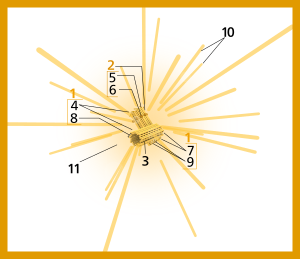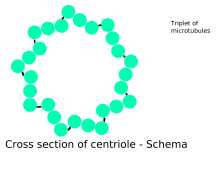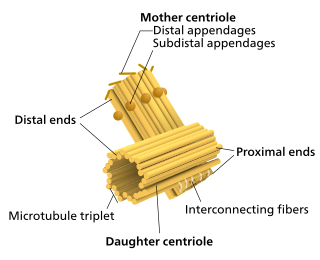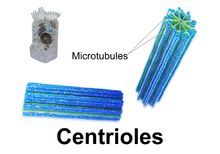Centriole
| Cell biology | |
|---|---|
| centrosome | |
 Components of a typical centrosome:
|

Incell biologyacentrioleis a cylindricalorganellecomposed mainly of a protein calledtubulin.[1]Centrioles are found in mosteukaryoticcells,but are not present in conifers (Pinophyta), flowering plants (angiosperms) and mostfungi,and are only present in the male gametes ofcharophytes,bryophytes,seedlessvascular plants,cycads,andGinkgo.[2][3]A bound pair of centrioles, surrounded by a highly ordered mass of dense material, called thepericentriolar material(PCM),[4]makes up a structure called acentrosome.[1]
Centrioles are typically made up of nine sets ofshort microtubuletriplets, arranged in a cylinder. Deviations from this structure includecrabsandDrosophila melanogasterembryos, with nine doublets, andCaenorhabditis eleganssperm cellsand early embryos, with nine singlets.[5][6]Additional proteins includecentrin,cenexinandtektin.[7]
The main function of centrioles is to produceciliaduringinterphaseand theasterand thespindleduring cell division.
History[edit]
The centrosome was discovered jointly byWalther Flemmingin 1875[8][9]andEdouard Van Benedenin 1876.[10][9]Edouard Van Benedenmade the first observation ofcentrosomesas composed of two orthogonal centrioles in 1883.[11]Theodor Boveriintroduced the term "centrosome" in 1888[12][9][13][14]and the term "centriole" in 1895.[15][9]Thebasal bodywas named byTheodor Wilhelm Engelmannin 1880.[16][9]The pattern of centriole duplication was first worked out independently byÉtienne de HarvenandJoseph G. Gallc. 1950.[17][18]
Role in cell division[edit]

Centrioles are involved in the organization of themitotic spindleand in the completion ofcytokinesis.[19]Centrioles were previously thought to be required for the formation of a mitotic spindle in animal cells. However, more recent experiments have demonstrated that cells whose centrioles have been removed vialaserablation can still progress through the G1stage ofinterphasebefore centrioles can be synthesized later in a de novo fashion.[20]Additionally, mutant flies lacking centrioles develop normally, although the adult flies' cells lackflagellaandciliaand as a result, they die shortly after birth.[21] The centrioles can self replicate during cell division.
Cellular organization[edit]
Centrioles are a very important part ofcentrosomes,which are involved in organizingmicrotubulesin thecytoplasm.[22][23]The position of the centriole determines the position of the nucleus and plays a crucial role in the spatial arrangement of the cell.

Fertility[edit]
Spermcentrioles are important for 2 functions:[24](1) to form the spermflagellumand sperm movement and (2) for the development of the embryo after fertilization. Thespermsupplies the centriole that creates the centrosome and microtubule system of the zygote.[25]
Ciliogenesis[edit]
Inflagellatesandciliates,the position of theflagellumorciliumis determined by the mother centriole, which becomes thebasal body.An inability of cells to use centrioles to make functional flagella and cilia has been linked to a number of genetic and developmental diseases. In particular, the inability of centrioles to properly migrate prior to ciliary assembly has recently been linked toMeckel–Gruber syndrome.[26]
Animal development[edit]

Proper orientation of cilia via centriole positioning toward the posterior of embryonic node cells is critical for establishingleft-right asymmetry,during mammalian development.[27]
Centriole duplication[edit]
BeforeDNA replication,cells contain two centrioles, an oldermother centriole,and a youngerdaughter centriole.Duringcell division,a new centriole grows at the proximal end of both mother and daughter centrioles. After duplication, the two centriole pairs (the freshly assembled centriole is now a daughter centriole in each pair) will remain attached to each otherorthogonallyuntilmitosis.At that point the mother and daughter centrioles separate dependently on anenzymecalledseparase.[28]
The two centrioles in the centrosome are tied to one another. The mother centriole has radiating appendages at thedistalend of its long axis and is attached to its daughter at theproximalend. Each daughter cell formed after cell division will inherit one of these pairs. Centrioles start duplicating when DNA replicates.[19]
Origin[edit]
The last common ancestor of alleukaryoteswas aciliatedcell with centrioles.[citation needed]Some lineages of eukaryotes, such asland plants,do not have centrioles except in their motile male gametes. Centrioles are completely absent from all cells ofconifersandflowering plants,which do not have ciliate or flagellate gametes.[29] It is unclear if the last common ancestor had one[30]or two cilia.[31]Important genes such ascentrinsrequired for centriole growth, are only found in eukaryotes, and not inbacteriaorarchaea.[30]
Etymology and pronunciation[edit]
The wordcentriole(/ˈsɛntrioʊl/) usescombining formsofcentri-and-ole,yielding "little central part", which describes a centriole's typical location near the center of the cell.
Atypical centrioles[edit]
Typical centrioles are made of 9 triplets ofmicrotubulesorganized with radial symmetry.[32]Centrioles can vary the number of microtubules and can be made of 9 doublets of microtubules (as inDrosophila melanogaster) or 9 singlets of microtubules as inC. elegans.Atypical centrioles are centrioles that do not have microtubules, such as theProximal Centriole-Likefound inD. melanogastersperm,[33]or that have microtubules with no radial symmetry, such as in the distal centriole of humanspermatozoon.[34]Atypical centrioles may have evolved at least eight times independently during vertebrate evolution and may evolve in the sperm afterinternal fertilizationevolves.[35]
It wasn't clear why centriole become atypical until recently. The atypical distal centriole forms a dynamic basal complex (DBC) that, together with other structures in the sperm neck, facilitates a cascade of internal sliding, coupling tail beating with head kinking. The atypical distal centriole's properties suggest that it evolved into a transmission system that couples the sperm tail motors to the whole sperm, thereby enhancing sperm function.[36]
References[edit]
- ^abEddé, B; Rossier, J; Le Caer, JP; Desbruyères, E; Gros, F; Denoulet, P (1990). "Posttranslational glutamylation of Alpha -tubulin".Science.247(4938): 83–5.Bibcode:1990Sci...247...83E.doi:10.1126/science.1967194.PMID1967194.
- ^Quarmby, LM; Parker, JD (2005)."Cilia and the cell cycle?".The Journal of Cell Biology.169(5): 707–10.doi:10.1083/jcb.200503053.PMC2171619.PMID15928206.
- ^Silflow, CD; Lefebvre, PA (2001)."Assembly and motility of eukaryotic cilia and flagella. Lessons from Chlamydomonas reinhardtii".Plant Physiology.127(4): 1500–1507.doi:10.1104/pp.010807.PMC1540183.PMID11743094.
- ^Lawo, Steffen; Hasegan, Monica; Gupta, Gagan D.; Pelletier, Laurence (November 2012)."Subdiffraction imaging of centrosomes reveals higher-order organizational features of pericentriolar material".Nature Cell Biology.14(11): 1148–1158.doi:10.1038/ncb2591.ISSN1476-4679.PMID23086237.S2CID11286303.
- ^Delattre, M; Gönczy, P (2004)."The arithmetic of centrosome biogenesis"(PDF).Journal of Cell Science.117(Pt 9): 1619–30.doi:10.1242/jcs.01128.PMID15075224.S2CID7046196.Archived(PDF)from the original on 18 August 2017.
- ^Leidel, S.; Delattre, M.; Cerutti, L.; Baumer, K.; Gönczy, P (2005). "SAS-6 defines a protein family required for centrosome duplication inC. elegansand in human cells ".Nature Cell Biology.7(2): 115–25.doi:10.1038/ncb1220.PMID15665853.S2CID4634352.
- ^Rieder, C. L.; Faruki, S.; Khodjakov, A. (October 2001). "The centrosome in vertebrates: more than a microtubule-organizing center".Trends in Cell Biology.11(10): 413–419.doi:10.1016/S0962-8924(01)02085-2.ISSN0962-8924.PMID11567874.
- ^Flemming, W. (1875). Studien uber die Entwicklungsgeschichte der Najaden. Sitzungsgeber. Akad. Wiss. Wien 71, 81–147
- ^abcdeBloodgood RA. From central to rudimentary to primary: the history of an underappreciated organelle whose time has come. The primary cilium. Methods Cell Biol. 2009;94:3-52. doi: 10.1016/S0091-679X(08)94001-2. Epub 2009 Dec 23. PMID 20362083.
- ^Van Beneden, E. (1876). Contribution a l’histoire de la vesiculaire germinative et du premier noyau embryonnaire. Bull. Acad. R. Belg (2me series) 42, 35–97.
- ^Wunderlich, V. (2002)."JMM - Past and Present".Journal of Molecular Medicine.80(9): 545–548.doi:10.1007/s00109-002-0374-y.PMID12226736.
- ^Boveri, T. (1888). Zellen-Studien II. Die Befruchtung und Teilung des Eies von Ascaris megalocephala. Jena. Z. Naturwiss. 22, 685–882.
- ^Boveri, T.Ueber das Verhalten der Centrosomen bei der Befruchtung des Seeigel-Eies nebst allgemeinen Bemerkungen über Centrosomen und Verwandtes.Verh. d. Phys.-Med. Ges. zu Würzburg, N. F., Bd. XXIX, 1895.link.
- ^Boveri, T. (1901).Zellen-Studien: Uber die Natur der Centrosomen. IV.Fischer, Jena.link.
- ^Boveri, T. (1895). Ueber die Befruchtungs und Entwickelungsfahigkeit kernloser Seeigeleier und uber die Moglichkeit ihrer Bastardierung. Arch. Entwicklungsmech. Org. (Wilhelm Roux) 2, 394–443.
- ^Engelmann, T. W. (1880). Zur Anatomie und Physiologie der Flimmerzellen. Pflugers Arch. 23, 505–535.
- ^Wolfe, Stephen L.(1977).Biology: the foundations(First ed.). Wadsworth.ISBN9780534004903.
- ^Vorobjev, I. A.; Nadezhdina, E. S. (1987).The Centrosome and Its Role in the Organization of Microtubules.International Review of Cytology. Vol. 106. pp. 227–293.doi:10.1016/S0074-7696(08)61714-3.ISBN978-0-12-364506-7.PMID3294718..See also de Harven's own recollections of this work:de Harven, Etienne (1994). "Early observations of centrioles and mitotic spindle fibers by transmission electron microscopy".Biology of the Cell.80(2–3): 107–109.doi:10.1111/j.1768-322X.1994.tb00916.x.PMID8087058.S2CID84594630.
- ^abSalisbury, JL; Suino, KM; Busby, R; Springett, M (2002)."Centrin-2 is required for centriole duplication in mammalian cells".Current Biology.12(15): 1287–92.doi:10.1016/S0960-9822(02)01019-9.PMID12176356.S2CID1415623.
- ^La Terra, S; English, CN; Hergert, P; McEwen, BF; Sluder, G; Khodjakov, A (2005)."The de novo centriole assembly pathway in HeLa cells: cell cycle progression and centriole assembly/maturation".The Journal of Cell Biology.168(5): 713–22.doi:10.1083/jcb.200411126.PMC2171814.PMID15738265.
- ^Basto, R; Lau, J; Vinogradova, T; Gardiol, A; Woods, CG; Khodjakov, A; Raff, JW (2006)."Flies without centrioles".Cell.125(7): 1375–86.doi:10.1016/j.cell.2006.05.025.PMID16814722.S2CID2080684.
- ^Feldman, JL; Geimer, S; Marshall, WF (2007)."The mother centriole plays an instructive role in defining cell geometry".PLOS Biology.5(6): e149.doi:10.1371/journal.pbio.0050149.PMC1872036.PMID17518519.
- ^Beisson, J; Wright, M (2003). "Basal body/centriole assembly and continuity".Current Opinion in Cell Biology.15(1): 96–104.doi:10.1016/S0955-0674(02)00017-0.PMID12517710.
- ^Avidor-Reiss, T., Khire, A., Fishman, E. L., & Jo, K. H. (2015). Atypical centrioles during sexual reproduction. Frontiers in cell and developmental biology, 3, 21. Chicago
- ^Hewitson, Laura & Schatten, Gerald P. (2003)."The biology of fertilization in humans".In Patrizio, Pasquale; et al. (eds.).A color atlas for human assisted reproduction: laboratory and clinical insights.Lippincott Williams & Wilkins. p. 3.ISBN978-0-7817-3769-2.Retrieved9 November2013.
- ^Cui, Cheng; Chatterjee, Bishwanath; Francis, Deanne; Yu, Qing; SanAgustin, Jovenal T.; Francis, Richard; Tansey, Terry; Henry, Charisse; Wang, Baolin; Lemley, Bethan; Pazour, Gregory J.; Lo, Cecilia W. (2011)."Disruption of Mks1 localization to the mother centriole causes cilia defects and developmental malformations in Meckel-Gruber syndrome".Dis. Models Mech.4(1): 43–56.doi:10.1242/dmm.006262.PMC3008963.PMID21045211.
- ^Babu, Deepak; Roy, Sudipto (1 May 2013)."Left–right asymmetry: cilia stir up new surprises in the node".Open Biology.3(5): 130052.doi:10.1098/rsob.130052.ISSN2046-2441.PMC3866868.PMID23720541.
- ^Tsou, MF; Stearns, T (2006). "Mechanism limiting centrosome duplication to once per cell cycle".Nature.442(7105): 947–51.Bibcode:2006Natur.442..947T.doi:10.1038/nature04985.PMID16862117.S2CID4413248.
- ^Marshall, W.F. (2009)."Centriole Evolution".Current Opinion in Cell Biology.21(1): 14–19.doi:10.1016/j.ceb.2009.01.008.PMC2835302.PMID19196504.
- ^abBornens, M.; Azimzadeh, J. (2007)."Origin and Evolution of the Centrosome".Eukaryotic Membranes and Cytoskeleton.Advances in Experimental Medicine and Biology. Vol. 607. pp.119–129.doi:10.1007/978-0-387-74021-8_10.ISBN978-0-387-74020-1.PMID17977464.
- ^Rogozin, I. B.; Basu, M. K.; Csürös, M.; Koonin, E. V. (2009)."Analysis of Rare Genomic Changes Does Not Support the Unikont-Bikont Phylogeny and Suggests Cyanobacterial Symbiosis as the Point of Primary Radiation of Eukaryotes".Genome Biology and Evolution.1:99–113.doi:10.1093/gbe/evp011.PMC2817406.PMID20333181.
- ^Avidor-Reiss, Tomer; Gopalakrishnan, Jayachandran (2013)."Building a centriole".Current Opinion in Cell Biology.25(1): 72–7.doi:10.1016/j.ceb.2012.10.016.PMC3578074.PMID23199753.
- ^Blachon, S; Cai, X; Roberts, K. A; Yang, K; Polyanovsky, A; Church, A; Avidor-Reiss, T (2009)."A Proximal Centriole-Like Structure is Present in Drosophila Spermatids and Can Serve as a Model to Study Centriole Duplication".Genetics.182(1): 133–44.doi:10.1534/genetics.109.101709.PMC2674812.PMID19293139.
- ^Fishman, Emily L; Jo, Kyoung; Nguyen, Quynh P. H; Kong, Dong; Royfman, Rachel; Cekic, Anthony R; Khanal, Sushil; Miller, Ann L; Simerly, Calvin; Schatten, Gerald; Loncarek, Jadranka; Mennella, Vito; Avidor-Reiss, Tomer (2018)."A novel atypical sperm centriole is functional during human fertilization".Nature Communications.9(1): 2210.Bibcode:2018NatCo...9.2210F.doi:10.1038/s41467-018-04678-8.PMC5992222.PMID29880810.
- ^Turner, K., N. Solanki, H.O. Salouha, and T. Avidor-Reiss. 2022. Atypical Centriolar Composition Correlates with Internal Fertilization in Fish. Cells. 11:758,https:// mdpi /2073-4409/11/5/758
- ^Khanal, S., M.R. Leung, A. Royfman, E.L. Fishman, B. Saltzman, H. Bloomfield-Gadelha, T. Zeev-Ben-Mordehai, and T. Avidor-Reiss. 2021. A dynamic basal complex modulates mammalian sperm movement. Nat Commun. 12:3808..https://doi.org/10.1038/s41467-021-24011-0
